Yucca Mutualism, Mouth Tentacles and the Shadow Self
The Yucca and the Yucca moth's deep interdependence is bizarre and instructive.

"If we could look into the psyche of the yucca moth, for instance, we would find in it a pattern of ideas, of a numinous or fascinating character, which … compels the moth to carry out its fertilising activity on the yucca plant."
– Carl Jung
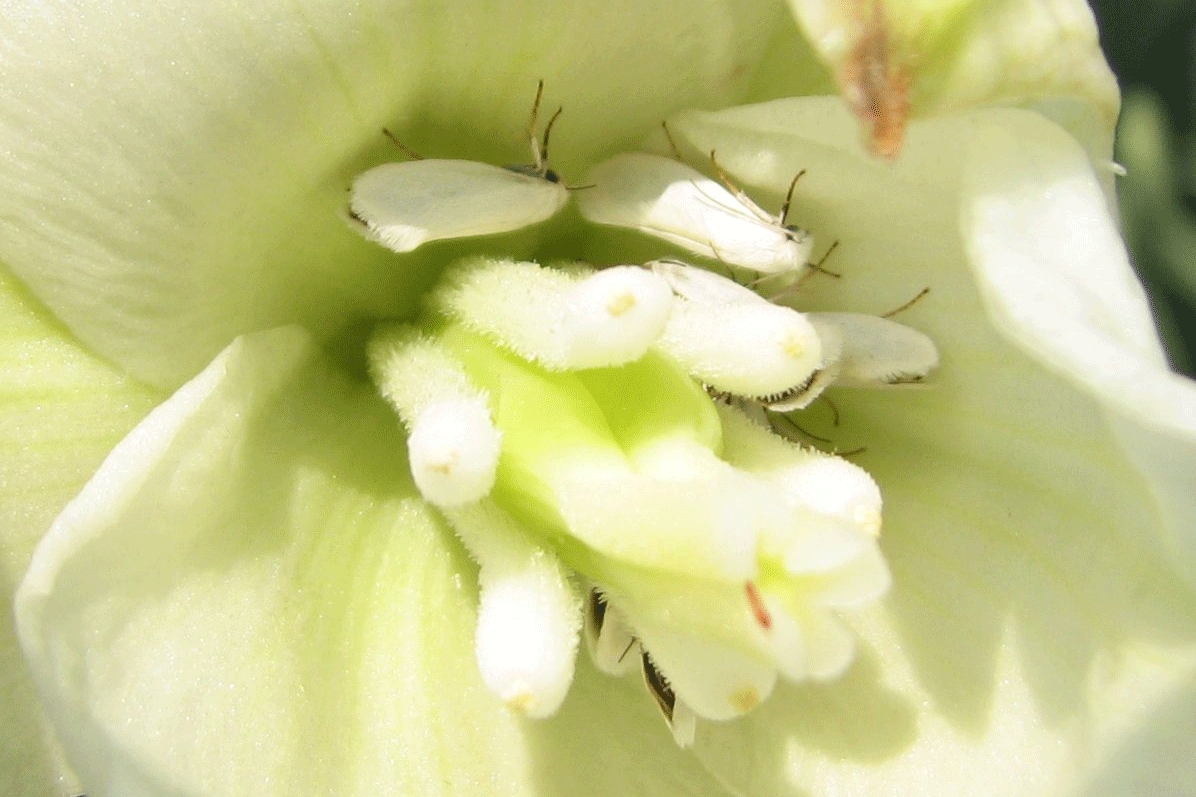
I follow the Denver Botanic Gardens on iNaturalist. Every month they have an "EcoQuest" - a citizen scientist activity for the community to help collectively monitor an aspect of our ecosystem.
This month's EcoQuest is identifying and sharing the locations of Soapweed Yucca (Yucca glauca).

The yucca is an iconic plant here in the southwest. They've helped out us humans in myriad ways. You can eat the flowers. You can dry out the leaves for cordage (and use the leaf tip as a needle) or chew one end to create a paintbrush. The roots can be crushed to produce a soapy juice for shampoo.
The yucca plant also has a unique symbiotic relationship to the yucca moth (Tegeticula yuccasella).
Yucca Mutualism
The yucca has only one pollinator, the yucca moth. And the yucca moth has only one food source, the yucca plant. In scientific land this is called obligate mutualism.
Awoken by Flower Scents
Yucca moths cocoon underground, near the Yucca plant. Come springtime, the yucca plant blossoms and releases a sweet scent into the air. The fragrance is strongest at night, when the nocturnal moth is most active.
Upon sensing the yucca's fragrance, the moth stirs- breaking from its cocoon and flying towards the flower.
Under the starry night, within the yucca blossoms which the moth's body mimics, it finds a mate (can you think of a more romantic setting?) and makes sweet moth love.
The adult male goes on to starve to death; its lifespan is so short it doesn't bother eating. Meanwhile the female starts its mission to continue the life of both its young and the yucca plant it depends on.
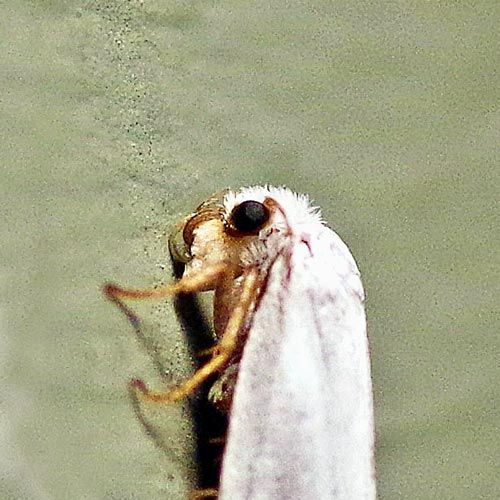
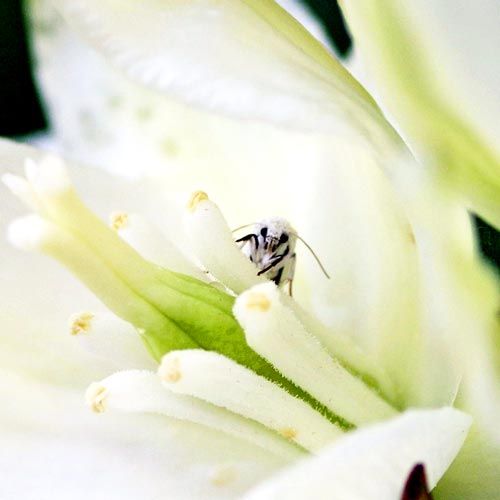
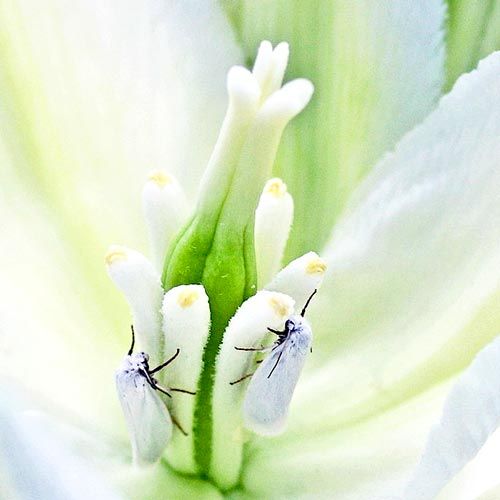
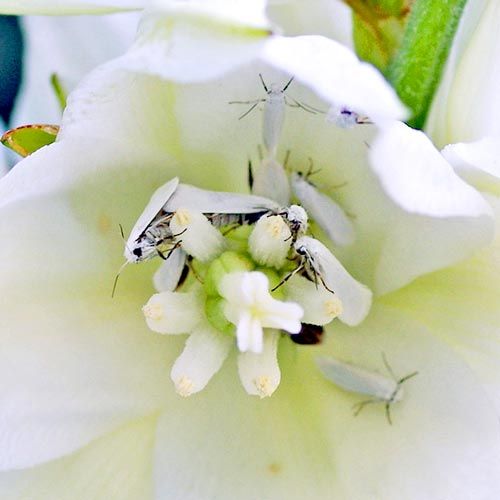
Yucca Moths Gather the Pollen With Their Tentacles
Yucca moths don't have your typical long proboscis for retrieving pollen. They have tentacles. That's right, tentacles. Like Davy Jones from Pirates of the Caribbean.

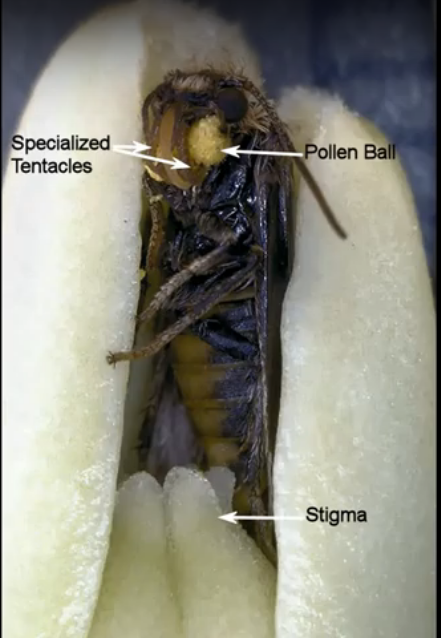
The female moths use these tentacles to gather up the pollen and keep it tucked under their chin.
Check it out.
With the pollen held tight with her mouth tentacles, she flies off to a completely separate yucca plant and its bunch of flowers, assuring cross pollination.
Momma Moth Lays Her Eggs in the Yucca Flower Ovary
When she arrives at a new plant, she inspects the flowers and chooses the ones that are at the right stage. She also checks if there are already eggs laid in the flower’s ovary. She smells for the scent of other female moths with her antennae and, if another one has already been there, she continues her search. This is good for the plant and for the future babies because, if too many eggs were laid in one flower ovary, the flower would abort and the larvae would starve. When she's found just the right flower, she lays a handful of her eggs (not too many or the flower would abort) in the ovary.
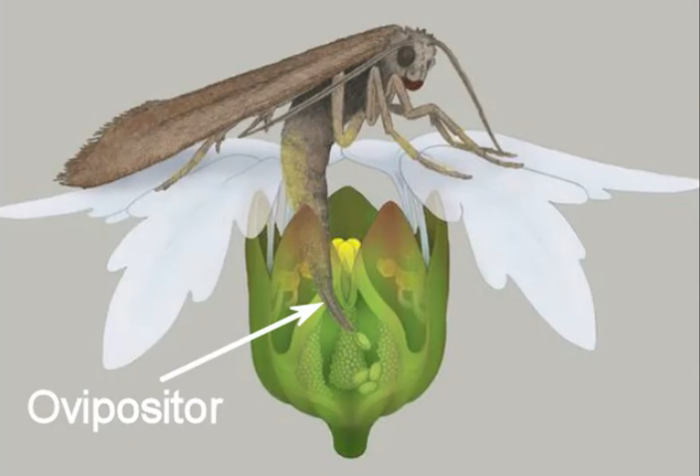
Mouth Tentacles Place the Pollen on the Stigma
To ensure that there will be seeds, she fertilizes the flower herself by carefully removing the pollen from under her chin and applying the pollen to the tip of the stigma (the top of the tube that leads to the ovary). It’s the only way the yucca can be pollinated.
She then rubs the area with her abdomen to deposit her pheromones and departs to repeat the process.
Now the flower will produce a fruit and enough seeds to feed the larvae as well as ensure the reproduction of the plant.
Babies Hatch and Feast
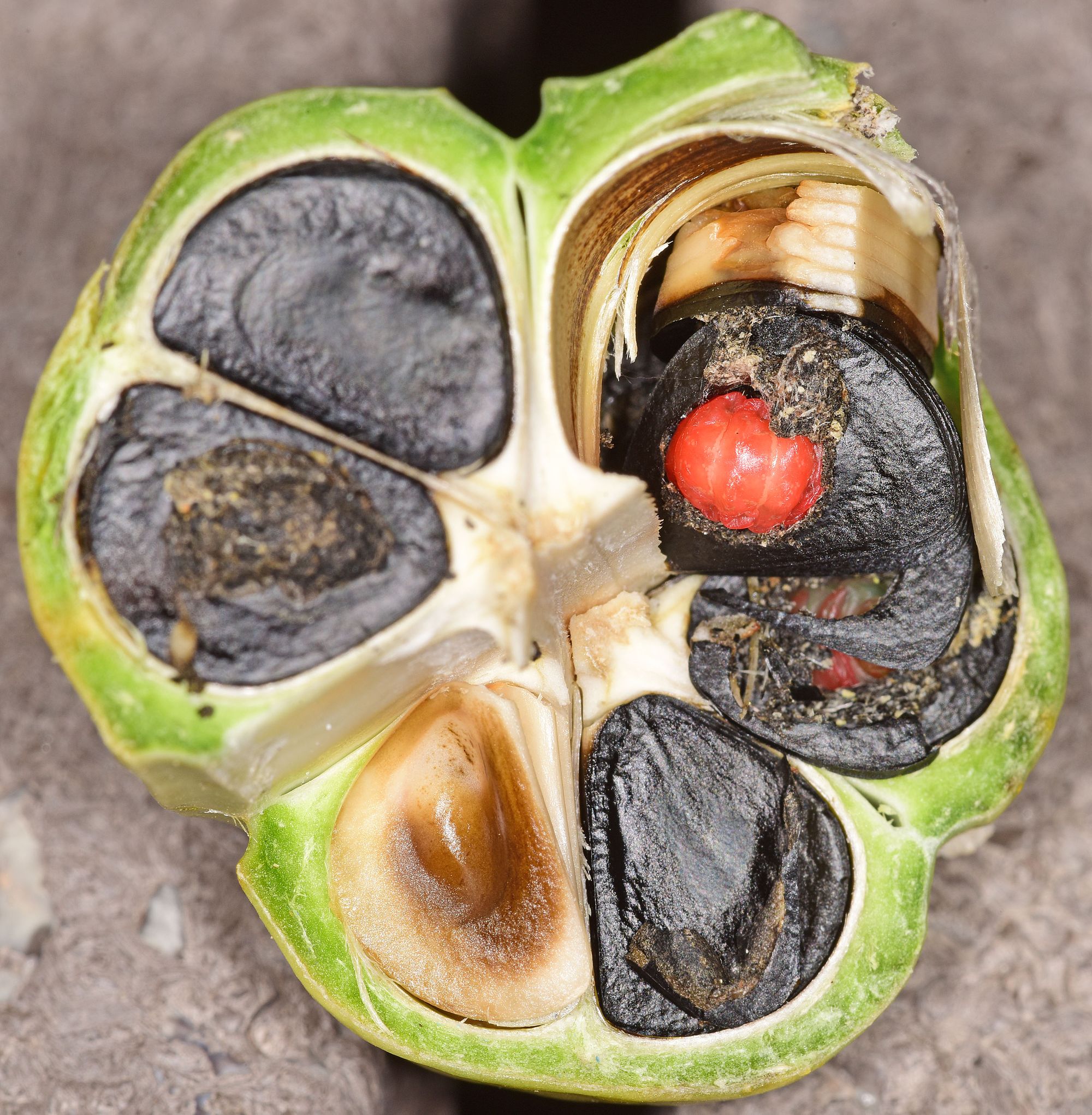
When the eggs hatch, the larvae feed on yucca seeds within the fruit. Typically, there are more seeds than the larvae can eat. In a few weeks, the larva is fully-grown. They then burrow out of the fruit – usually during rain events, – and buries itself underground, making their cocoon. It will stay underground until the next spring, hatching when the yucca blossoms emerge and their scent awakens the moths from dormancy. If for whatever reason the yucca does not bloom, then the moth waits patiently for the next season. The moths can wait up to ten years for a yucca bloom.
The Yucca Moth and the Archetype
While researching the yucca symbiosis I read this comment on a YouTube video of moth enthusiasts finding yucca moths.
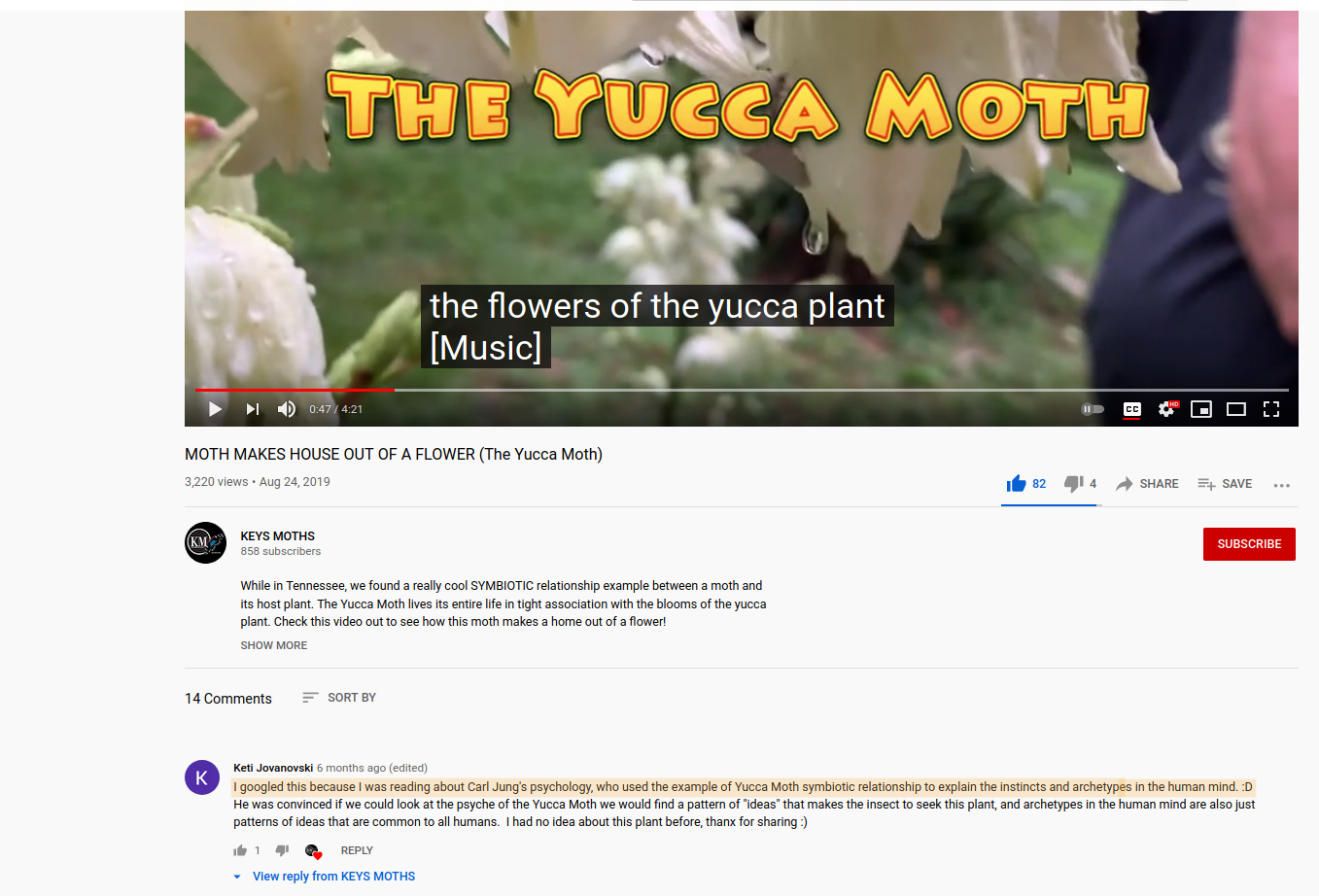
This is where everything becomes connected.
As I was deep in this research hole about Yucca symbiosis my partner was elsewhere in the house, exploring her shadow self - the very concept Jung postulated, inspired by the yucca moth.
I looked it up for myself and sure enough, the yucca moth served as inspiration for Jung's theories on the psyche, shared experience, archetypes, the shadow self, etc.
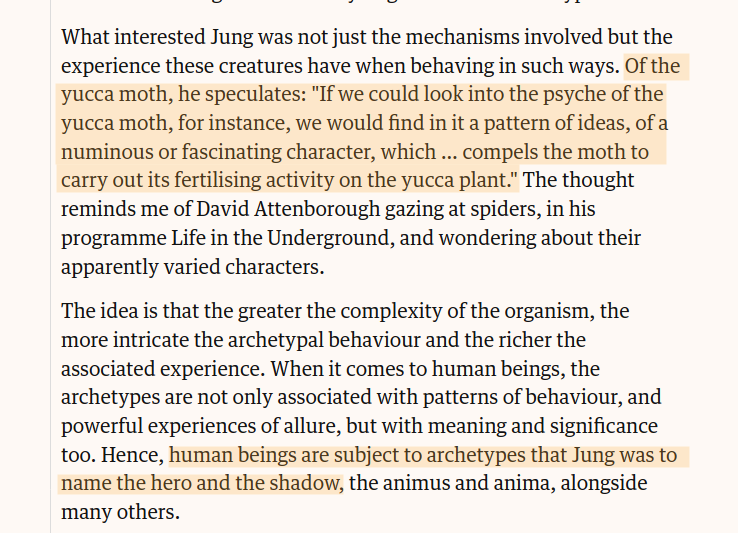
The coincidences continue. Like the yucca moth, my partner too had mouth tentacles - from a shadow mask they constructed, inspired by that clever, vulnerable little creature, the octopus.

From Antagonism to Mutualism
Jung isn't the only person to draw meaning from the symbiosis of the yucca plant and the yucca moth. Many Christians point to this unique relationship as an example of intelligent design, like this kid shares in his somewhat adorable research report.
But while Jackson is right to marvel at the wondrous interdependence of the yucca plant to the moth, a YouTube commenter lays out some harsh truth to this idea of intelligent design.

Whether the universe was actually created by a higher power, I can't say for sure. However, Katherine Bone does make an important point. A similar moth species, the Prodoxus, will lay their eggs in the yucca after seed fertilization is over, not contributing at all to the well being of the yucca plant. These moths are called "bogus yucca moths." Kind of mean, but it is a bit bogus that they're free loading like that.
The bigger point here is that the special, mutually beneficial relationship between the "real" yucca moth and yucca plant is one that was learned over time. The mutualism we see in the world took years and years of learning. Plants and insects started out with antagonized orientations towards one another. Insects were parasitic, consuming as much of the plant as they could, while the plant would shut down and creates defense mechanisms to protect itself. Over time, certain insects and plants formed relationships of understanding and trust.
There are two profound insights held in these examples of mutualism. One is that mutualism is learned through the communication of needs to arrive at relationships that are mutually beneficial. The other is that when we achieve that mutualism we thrive. The most sophisticated, vibrant ecosystems are bound together in this mutualism. Something that the anarchist formerly known as a prince, Peter Kropotkin, learned when studying the Siberian tundra.

Rather than the "dog eat dog" world capitalists were interpreting from Darwin's On the Origin of Species he found wild dogs to actually be working together to kill and then eat their prey as a mutually benefitting unit. Even the prey they killed was done in a way that ensured the prey's overall health. He dubbed this natural phenomenon mutual aid.
This messy process of moving from antagonism to mutualism is being played out right now. In the midst of a pandemic, we are seeing how our well being is bound up in one another. The forces of white supremacy, patriarchy and capitalism which lives off of antagonism hasn't been able to even protect those it purports to benefit.
Instead, community initiated systems of support are the ones flourishing and meeting our needs- many of these projects are literally called mutual aid groups. May we each listen deeply to one another so that we forge the kind of care, attention and reciprocity the yucca plant and moth have learned.
And also grow mouth tentacles!!